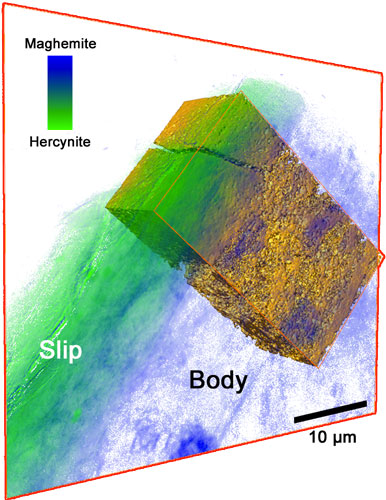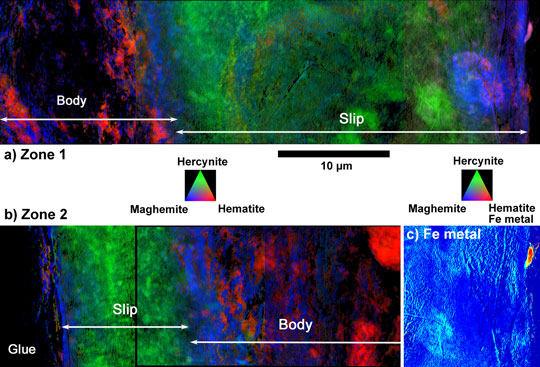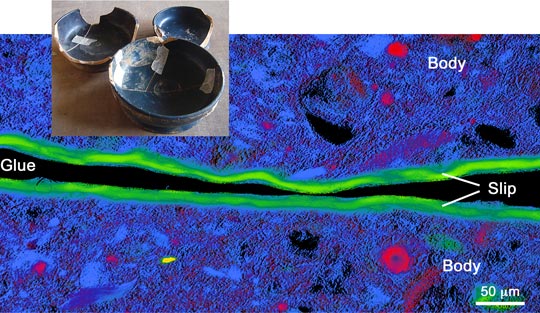- Home
- News
- Spotlight on Science
- Iron phase distribution...
Iron phase distribution analysis reveals the firing protocol of ancient ceramics
17-12-2013
Although fragments of ancient ceramics remain, details of the technologies used in their production have been almost entirely lost. By studying two black gloss sherds from the Roman period with full-field XANES microscopy, we have shown that these lost technologies can be reconstructed, and that even small but significant changes taking place over a period of less than 100 years can be elucidated.
Share
Fine ceramics with black high gloss slip on red bodies, manufactured in the Mediterranean basin from the sixth century BCE to the first century CE, were a benchmark of technological innovation in high temperature redox chemistry [1]. This technology, first developed in Corinth and Athens (sixth century BCE), slowly moved west to central and northern Italy (fourth century BCE) and finally to southern Roman Gaul where it vanished in the early decades of the first century CE. Although several tens of thousands of ceramic fragments have survived, a detailed technological protocol on how they were produced is almost entirely lost. Our samples were two black gloss sherds from the Roman period. By probing their mineralogical variation and distribution, we can reconstruct some of this lost technology. Our results also indicate that although the basic Fe redox chemistry remained unchanged for over 600 years, significant changes in the firing protocol took place even over a span of less than 100 years [2].
Because the minerals that reveal the lost processing conditions are often very heterogeneously distributed and confined to near surface and interfacial regions between the ceramic body and the slip, a probe with high spatial resolution, large field of view and high sensitivity to mineralogy is required to map them. A new spectromicroscopy technique was recently developed at ID21 (ESRF[3]) and BL 6-2 (SSRL[4]) that fulfils these requirements. It combines XANES and full-field imaging capabilities and has proven invaluable in allowing us to tease out easy-to-miss mineralogical differences in highly heterogeneous materials.
Full-field spectromicroscopy at ID21 allowed us to map the Fe-phases in a Campanian ceramic (first century BCE, Italy), see Figure 1, and a similar microscope at SSRL allowed us to correlate Fe mineralogy with 3D porosity for another fragment from the same sherd (Figure 2). The phase maps show that dense zones (slip and some body regions) are hercynite (Fe2+, green in Figure 1), while more oxygen permeable regions were predominantly maghemite (Fe3+, blue in Figure 1). Similar phase maps (Figure 3) were obtained for a Pre-sigillata ceramic (first century CE, Roman France). The mineralogical maps from the two sherds show subtle but significant differences.
The presence and distribution of maghemite, an intermediate Fe3+ mineral formed during re-oxidation of hercynite, is the key to some of the firing protocols. Occurrences of maghemite at the outside surface and the interface between slip and body, and especially the tendril like incursion from oxidised to reduced areas visible in Figure 2, in both ceramics is compelling and very pictorial evidence that these vessels were once reduced and then partially re-oxidised. Furthermore, a relatively uniform hercynite slip and nearly absent re-oxidation layer on the surface indicates a successful firing protocol that allowed the body to re-oxidise while preventing most of the slip from doing so. This remarkable achievement, that would be difficult even in modern replications, suggests the mastery of great skill in controlling the redox chemistry through sophisticated manipulation of clay chemistry and morphology and kiln firing conditions.
 |
|
Figure 2. Registration of the 3D tomographic data with the 2D mosaic phase map of the cross-section Campanian sample (SSRL, BL 6-2c). |
Differences between the maghemite/hematite distribution of the two sherds suggest differences in the firing protocol. There is a very patchy and, when present, very thin oxidation layer on the surface of the Campanian slip in contrast to a thicker and more uniform layer on the Pre-sigillata slip. There is also an absence of hematite, except for a few small islands centred on embedded crystals, in the body of the Campanian sherd as opposed to the mostly hematite body of the Pre-sigillata sherd. These two critical differences, when combined with the presence of patches of un-oxidised Fe2+ minerals in the body (almandine particle, and small patches of hercynite), suggest that the final re-oxidation step (in the three phase firing protocol, first outlined by Noble [1]) for the Campanian ceramic must have occurred at significantly lower temperature and/or shorter duration than that for the Pre-sigillata ceramic.
 |
|
Figure 3. Fe phase maps of the cross-section Pre-sigillata sample recorded at SSRL. |
In conclusion, we believe that our results show that applications of full-field XANES microscopy will have profound impact for the recovery of lost ancient ceramic technology. Its versatility will also lead to a deeper understanding of the functioning of other complex, hierarchically heterogeneous systems, such as heterogeneous catalysts and energy storage systems.
Principal publication and authors
Full-field XANES analysis of Roman ceramics to estimate firing conditions - a novel probe to study hierarchical heterogeneous materials, F. Meirer (a), Y. Liu (b), E. Pouyet (c), B. Fayard (c), M. Cotte (c, d), C. Sanchez (e), J.C. Andrews (b), A. Mehta (b) and P. Sciau (f), J. Anal. At. Spectrom. 28, 1870-1883 (2013).
(a) Debye Institute for Nanomaterials Science, Utrecht (Netherlands)
(b) SSRL-SLAC, Menlo Park (USA)
(c) ESRF
(d) Laboratoire d’Archéologie Moléculaire et Structurale, CNRS, Ivry-sur-Seine (France)
(e) Archéologie des Sociétés Méditerranéennes, CNRS, Lattes (France)
(f) CEMES-CNRS, Toulouse (France)
References
[1] J.V. Noble, The techniques of painted Attic pottery, New York (1965).
[2] P. Sciau, Y. Leon, P. Goudeau, S.C. Fakra, S. Webb and A. Mehta, J. Anal. At. Spectrom., 26, 969 (2011).
[3] B. Fayard, E. Pouyet, G. Berruyer, D. Bugnazet, C. Cornu, M. Cotte, V. De Andrade, F. Di Chiaro, O. Hignette, J. Kieffer, T. Martin, E. Papillon, M. Salomé, V.A. Sole, Journal of Physics: Conference Series 425, 192001 (2013).
[4] F. Meirer, J. Cabana, Y.J. Liu, A. Mehta, J.C. Andrews and P. Pianetta, Journal of Synchrotron Radiation, 18, 773 (2011).
Top image: Full-field XANES imaging was used to identify the mineral species present and their distribution within ancient ceramics.




